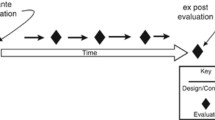Abstract
Considering the competitive business scenario of the IT world, websites are the key aspect for satisfying the user’s demands. Thus, usability evaluation is the hidden measure to succeed in this competitive environment. Measuring user satisfaction is a hindering job because of lack of appropriate methodologies. This paper addresses these issues by considering AHP based usability evaluation technique to measure the usability score of a website. The proposed methodology evaluates user satisfaction for three different websites based on feedback mechanism for different usability attributes. Feedback is collected using Questionnaire methodology. AHP is a multi-criteria decision making algorithm that proves to be the reliable way for the user to make a decision for choosing the best website that fulfills user satisfaction.





Similar content being viewed by others
References
Al-Azab FGM, Ayu MA (2010) Web based multi-criteria decision making using AHP method. In: International conference on information and communication technology for the Muslim world (ICT4M), pp A6–A12
Bratati C, Roy S, Pattnaik PK (2014) User satisfaction metrics for cloud computing environment. Eur J Acad Essays 1(3):63–69
Chaparro BS (2008) Usability evaluation of a university portal website. Usability News 10(2)
Kostaras N, Xenos M (2007) Assessing educational web-site usability using heuristic evaluation rules. In: 11th Panhellenic conference in informatics, 18–20 May, pp 543–550
Manzoor M, Hussain W (2012) A web usability evaluation model for higher education providing universities of Asia. Sci Tech Dev 31(2):183–192
Mentes SA, Turan AH (2012) Assessing the usability of university websites: an empirical study on Namik Kemal University. Turk Online J Educ Technol 11(3):61–69
Roy S, Pattnaik PK (2013) Some popular usability evaluation techniques for websites. Adv Intell Syst Comput 247:535–543
Roy S, Pattnaik PK, Mall R (2014) A quantitative approach to evaluate usability of academic websites based on human perception. Egypt Inform J 15(3):159–167
Saaty TL (1980) The analytic hierarchy process. McGraw-Hill, New York
Sorum H, Andersen KN, Vatrapu R (2012) Public websites and human-computer interaction: an empirical study of measurement of website quality and user satisfaction. Behaviour and Information Technology 31(7):697–706
Yigit T, Isik AH, Ince M (2014) Web-based learning object selection software using analytical hierarchy process. IET Softw J 8(4):174–183
Author information
Authors and Affiliations
Corresponding author
Appendix
Appendix
The questionnaires associated with this work for getting online user feedback are mentioned below:
-
1.
Is the website’s design aesthetically appealing?
-
2.
Are the colors used on each page of the website harmonious and related logically?
-
3.
Is the information available under each section of the website systematically arranged?
-
4.
Is the website looks professional and informative while searching any information?
-
5.
Are the colors of the text and background contrast for easy retrieval of information?
-
6.
Is the redirecting feature present in each of the webpage successfully fulfilling the purpose of the user?
-
7.
Are the navigation features present in both flash as well as in text format?
-
8.
Whether the navigation is intuitive?
-
9.
Whether the information provided frequently for the same query is consistent?
-
10.
How many maximum numbers of clicks are required for searching of information from the website?
-
11.
What is the minimum and maximum time taken by the user for completion of each task?
-
12.
For each click, how much time is required for providing the response?
-
13.
Did the website provide the information within a stipulated period of time?
-
14.
Whether the information provided in the website are regularly updated?
-
15.
Is there any spelling mistake or error present in the website?
-
16.
Is the basic website layout logically perfect?
-
17.
Are the websites require too much intervention & involvement of user for finding any information?
-
18.
Whether the information present in the website can be retrieved easily for every access?
-
19.
Whether each page provides further links for getting more descriptive information?
-
20.
Is it easier to use the website for getting information?
Rights and permissions
About this article
Cite this article
Roy, S., Pattnaik, P.K. & Mall, R. Quality assurance of academic websites using usability testing: an experimental study with AHP. Int J Syst Assur Eng Manag 8, 1–11 (2017). https://doi.org/10.1007/s13198-016-0436-0
Received:
Revised:
Published:
Issue Date:
DOI: https://doi.org/10.1007/s13198-016-0436-0




